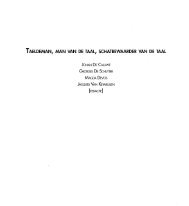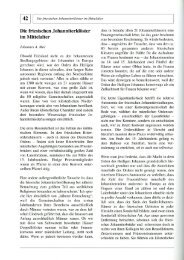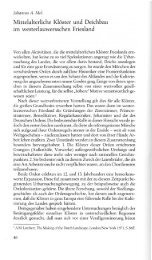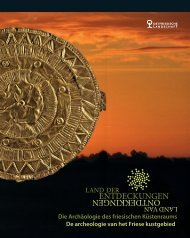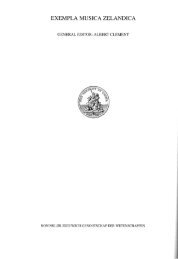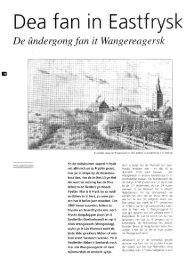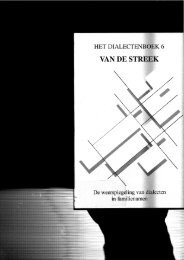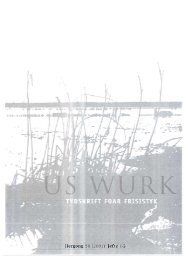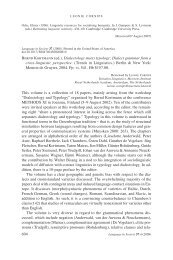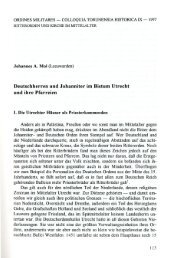The Lantern-Roofed Tombs in Thrace and Anatolia: Some Evidence ...
The Lantern-Roofed Tombs in Thrace and Anatolia: Some Evidence ...
The Lantern-Roofed Tombs in Thrace and Anatolia: Some Evidence ...
You also want an ePaper? Increase the reach of your titles
YUMPU automatically turns print PDFs into web optimized ePapers that Google loves.
Proceed<strong>in</strong>gs of the 10th International Congress of Thracology.<br />
<strong>The</strong> <strong>Lantern</strong>-<strong>Roofed</strong> <strong>Tombs</strong> <strong>in</strong> <strong>Thrace</strong> <strong>and</strong> <strong>Anatolia</strong>:<br />
1<br />
Athens 2006 (forthcom<strong>in</strong>g)<br />
<strong>Some</strong> <strong>Evidence</strong> about Cultural Relations <strong>and</strong> Interaction<br />
<strong>in</strong> the East Mediterranean *<br />
Nikola <strong>The</strong>odossiev<br />
<strong>The</strong> lantern (or diagonal) roof<strong>in</strong>g is specific technique applied <strong>in</strong> the<br />
ancient architecture, well attested <strong>in</strong> a number of rectangular chambers of<br />
tumular tombs <strong>in</strong> <strong>Thrace</strong> <strong>and</strong> <strong>Anatolia</strong>. Several scholarly works deal <strong>in</strong><br />
details with this particular technique, 1 which is perhaps best described <strong>in</strong><br />
English by Janos Fedak: ‘This type of roof is made up of long flat slabs<br />
form<strong>in</strong>g a series of superimposed ‘frames’ of more or less square shape; the<br />
slabs of each ‘frame’ were laid diagonally across the corners of the ‘frame’<br />
below. <strong>The</strong> squares gradually decreased <strong>in</strong> size from one course to the next,<br />
until the rema<strong>in</strong><strong>in</strong>g open<strong>in</strong>g was small enough to be closed without<br />
difficulty.’ 2<br />
However, the different publications related to such monuments usually<br />
give various accounts of the lantern roof<strong>in</strong>g <strong>and</strong> very often, those<br />
descriptions do not provide clear idea on the architectural features of the<br />
constructions. In fact, this specific technique became widely known to the<br />
scholars with the excavation of tumulus C near Karalar <strong>in</strong> Galatia, where a<br />
Late Hellenistic lantern-roofed tomb presumably built for a burial of some<br />
Gaulish chiefta<strong>in</strong> was discovered <strong>in</strong> 1933. 3 Shortly after, the lantern-roofed<br />
tomb at Karalar was designated as ‘Galatisches Kuppelgrab’ 4 <strong>and</strong> later, the
diagonal roof<strong>in</strong>g was even described as ‘a “Galatian” corbeled roof system’ 5<br />
or ‘voûte «galate»’ 6 . Actually, the lantern roof<strong>in</strong>g was applied <strong>in</strong> the<br />
<strong>Anatolia</strong>n funerary architecture much earlier than the Karalar example <strong>and</strong><br />
was first attested <strong>in</strong> the Archaic tumular tomb at Belevi 7 , while many<br />
scholars consider that this type of stone roof orig<strong>in</strong>ated <strong>in</strong> timber<br />
construction of <strong>Anatolia</strong>n houses contemporary to the earliest monumental<br />
tombs 8 . <strong>The</strong>refore, any term<strong>in</strong>ology bear<strong>in</strong>g particular ethnic or strict<br />
regional implications, such as ‘a “Galatian” corbel’, may not be correct<br />
when referr<strong>in</strong>g to this technique.<br />
Three approximately synchronous tombs with lantern roof<strong>in</strong>g are known<br />
<strong>in</strong> ancient <strong>Thrace</strong> so far. <strong>The</strong> first one was discovered <strong>in</strong> 1931 <strong>in</strong> Kurtkale<br />
locality near Mezek. 9 <strong>The</strong> funerary monument is situated on the ground level<br />
<strong>in</strong> the eastern part of a big tumulus <strong>and</strong> consists of façade, rectangular<br />
lantern-roofed antechamber <strong>and</strong> beehive tholos burial chamber. <strong>The</strong><br />
Kurtkale tomb dates to the last decades of the 4th or first decades of the 3rd<br />
century B.C. Another similar tomb was excavated <strong>in</strong> 1976 <strong>in</strong> Zhaba Mogila<br />
tumulus, which is about 20 m <strong>in</strong> height <strong>and</strong> 80-90 m <strong>in</strong> diameter, <strong>and</strong> is<br />
located near Strelcha. 10 <strong>The</strong> monument is situated <strong>in</strong> the southeastern<br />
periphery of the mound on the ground level <strong>and</strong> consists of façade,<br />
rectangular lantern-roofed antechamber <strong>and</strong> beehive tholos burial chamber.<br />
It is dated to the last decades of the 4th century B.C. <strong>The</strong> third Thracian<br />
tomb with lantern roof<strong>in</strong>g was excavated <strong>in</strong> 1952 <strong>in</strong> a tumulus <strong>in</strong> Golemiya<br />
Aigar locality near Plovdiv (ancient Philippopolis). 11 <strong>The</strong> monument is<br />
situated on the level of the ancient terra<strong>in</strong> <strong>in</strong> the central part of the mound<br />
<strong>and</strong> displays a ground-plan different from the previous funerary<br />
constructions, consist<strong>in</strong>g of façade, rectangular antechamber <strong>and</strong> rectangular<br />
2
lantern-roofed burial chamber. <strong>The</strong> Plovdiv tomb comes from the end of the<br />
4th or first decade of the 3rd century B.C.<br />
However, while <strong>in</strong> <strong>Thrace</strong> only three monuments display<strong>in</strong>g such<br />
technique are known, this k<strong>in</strong>d of roof<strong>in</strong>g seems to be widely used <strong>in</strong><br />
<strong>Anatolia</strong>. <strong>The</strong> tumular tomb at Belevi near Ephesos, first noted <strong>in</strong> 1827,<br />
dates to the 6th century B.C. <strong>and</strong> provides the earliest example of lantern<br />
roof<strong>in</strong>g <strong>in</strong> the ancient world known so far. 12 <strong>The</strong> funerary monument is<br />
situated <strong>in</strong> the southern half of a big tumulus surrounded with krepis <strong>and</strong><br />
consists of long dromos, rectangular antechamber, a second rectangular<br />
lantern-roofed antechamber <strong>and</strong> rectangular burial chamber. <strong>The</strong> f<strong>in</strong>ds from<br />
the mound clearly <strong>in</strong>dicate that the Archaic monumental tomb was<br />
presumably a heroon <strong>and</strong> was used for secondary ritual activities dur<strong>in</strong>g<br />
extended period – until the Early Hellenistic Age. Actually, <strong>in</strong> <strong>Anatolia</strong>, the<br />
lantern-roofed tombs became widespread only dur<strong>in</strong>g the Late Classical <strong>and</strong><br />
Hellenistic Age <strong>and</strong> the architects who built these funerary monuments were<br />
presumably <strong>in</strong>spired from some early remarkable constructions, such as the<br />
tumular tomb at Belevi.<br />
Hellenistic lantern-roofed tombs were discovered <strong>in</strong> several parts of<br />
<strong>Anatolia</strong>. <strong>The</strong> closest region to <strong>Thrace</strong> appears to be Bithynia where four<br />
funerary monuments of this type are known, thus form<strong>in</strong>g the most<br />
significant regional group of lantern-roofed tombs <strong>in</strong> <strong>Anatolia</strong>. Two of them<br />
are located on the southern shore of Propontis. <strong>The</strong> tomb at Mudanya<br />
(ancient Myrleia) was unearthed <strong>in</strong> 1926 dur<strong>in</strong>g digg<strong>in</strong>g of Alçakbayir<br />
tumulus, about 30 m <strong>in</strong> height. 13 <strong>The</strong> monument consists of long dromos <strong>and</strong><br />
rectangular lantern-roofed burial chamber. It dates to the second half of the<br />
4th century B.C. Another tomb was accidentally uncovered <strong>in</strong> Küçük Çukur<br />
locality near Gemlik (ancient Kios) <strong>in</strong> a tumulus, which was destroyed<br />
3
dur<strong>in</strong>g construction works <strong>in</strong> the middle of 1960s. 14 <strong>The</strong> funerary monument<br />
consists of short dromos <strong>and</strong> rectangular lantern-roofed burial chamber, <strong>and</strong><br />
comes from the second half of the 4th century B.C. Two other tombs were<br />
discovered <strong>in</strong> the <strong>in</strong>l<strong>and</strong> of Bithynia – towards the border with Phrygia <strong>and</strong><br />
Galatia. <strong>The</strong> first one was <strong>in</strong>vestigated <strong>in</strong> 1974 <strong>in</strong> a tumulus close to Iğdir<br />
Köyü. 15 <strong>The</strong> monument consists of short dromos <strong>and</strong> rectangular lantern-<br />
roofed burial chamber. It dates to the 4th century B.C. <strong>and</strong> most probably to<br />
the second half of the century. <strong>The</strong> other tomb was excavated <strong>in</strong> 1989 <strong>in</strong><br />
Yalacik tumulus close to Yukari Bağdere. 16 <strong>The</strong> monument consists of long<br />
dromos, rectangular antechamber <strong>and</strong> rectangular lantern-roofed burial<br />
chamber. It is dated to the 2nd – 1st century B.C., but an earlier date <strong>in</strong> the<br />
Hellenistic Age could be also considered.<br />
Close to the West of Mudanya <strong>and</strong> Gemlik, <strong>in</strong> Propontic Mysia, another<br />
tomb of this type was excavated <strong>in</strong> Közemtüg tumulus at Daskyleion dur<strong>in</strong>g<br />
the 1990 campaign. 17 <strong>The</strong> monument consists of long dromos, rectangular<br />
antechamber <strong>and</strong> rectangular lantern-roofed burial chamber. It is proposed<br />
that the tomb comes from the first half of the 4th century B.C., but a<br />
presumable later date to c. 330 B.C. should not be excluded, too. Another<br />
tomb with lantern-roofed burial chamber was unearthed <strong>in</strong> the middle of<br />
1950s near Kepsut, located <strong>in</strong> the <strong>in</strong>l<strong>and</strong> of Mysia. 18 <strong>The</strong> brief <strong>in</strong>formation<br />
on this discovery allows suppos<strong>in</strong>g that the monument could be dated to the<br />
Late Classical or Hellenistic Age. A third similar tomb was excavated <strong>in</strong> the<br />
beg<strong>in</strong>n<strong>in</strong>g of 1960s at Musahocaköy <strong>in</strong> the southern part of Mysia – close to<br />
the border with Lydia. 19 It is situated <strong>in</strong> a tumulus <strong>and</strong> consists of long<br />
dromos, rectangular antechamber <strong>and</strong> rectangular lantern-roofed burial<br />
chamber. <strong>The</strong> tomb most probably comes from the Late Classical or<br />
Hellenistic Age. In fact, among all other <strong>Anatolia</strong>n tombs of this type, the<br />
4
monument at Musahocaköy is located closest to the Archaic Belevi chamber<br />
tomb, which presumably was one of the significant funerary constructions<br />
that exercised impact on architects to beg<strong>in</strong> widely apply<strong>in</strong>g the lantern<br />
roof<strong>in</strong>g dur<strong>in</strong>g the Late Classical <strong>and</strong> Hellenistic Age.<br />
Close to the East of Mysia, <strong>in</strong> Phrygia, three lantern-roofed tombs are<br />
known. <strong>The</strong> first one was discovered <strong>in</strong> 1954 under tumulus O at Gordion. 20<br />
It consists of rectangular lantern-roofed antechamber <strong>and</strong> rectangular<br />
lantern-roofed burial chamber. <strong>The</strong> funerary monument dates to the 2nd –<br />
1st century B.C. Two other tombs are situated at Hierapolis. 21 Unless almost<br />
all lantern-roofed funerary monuments known <strong>in</strong> <strong>Anatolia</strong> <strong>and</strong> <strong>Thrace</strong>, the<br />
Hierapolis tombs are constructed <strong>in</strong> rectangular pits under the ground level –<br />
not with<strong>in</strong> tumuli. <strong>The</strong> monuments consist of rectangular lantern-roofed<br />
burial chambers <strong>and</strong> are approximately dated to the 1st century BC, although<br />
an earlier dat<strong>in</strong>g may be considered, too.<br />
As mentioned above, <strong>in</strong> 1933, a lantern-roofed tomb was excavated at<br />
Karalar <strong>in</strong> Galatia, to the East of Phrygia. 22 <strong>The</strong> monument is situated under<br />
tumulus C <strong>and</strong> consists of rectangular lantern-roofed antechamber <strong>and</strong><br />
rectangular lantern-roofed burial chamber. <strong>The</strong> tomb comes from the 1st<br />
century B.C.<br />
F<strong>in</strong>ally, quite unusual example of lantern roof<strong>in</strong>g is attested <strong>in</strong><br />
Paphlagonia, to the East of Bithynia <strong>and</strong> to the North of Galatia. This is the<br />
rock-cut tomb <strong>in</strong> Gerdek Boğazi locality near Karakoyunlu. 23 <strong>The</strong> monument<br />
consists of impressive façade, rectangular antechamber, two rectangular side<br />
chambers – one of them with lantern-roofed ceil<strong>in</strong>g, <strong>and</strong> rectangular burial<br />
chamber. <strong>The</strong> rock-cut tomb is approximately dated to the second half of the<br />
4th century B.C.<br />
5
Obviously, the lantern-roofed tombs <strong>in</strong> <strong>Thrace</strong> <strong>and</strong> <strong>Anatolia</strong> provide a<br />
welcome opportunity of study<strong>in</strong>g the exchange of ideas <strong>and</strong> the various<br />
<strong>in</strong>terrelations <strong>in</strong> the tomb architecture between these parts of the ancient<br />
world. Moreover, the monuments allow explor<strong>in</strong>g the level of multilateral<br />
<strong>in</strong>teraction between different ethnic groups who <strong>in</strong>habited both areas.<br />
<strong>The</strong> limit of the present article does not allow study<strong>in</strong>g <strong>in</strong> details all these<br />
important topics. However, it is clear that while dur<strong>in</strong>g the Late Classical<br />
<strong>and</strong> Hellenistic Age the barrel-vaulted rectangular tombs became most<br />
spread <strong>in</strong> Macedonia 24 <strong>and</strong> the beehive tholos tombs became widespread <strong>in</strong><br />
<strong>Thrace</strong> 25 , the lantern-roofed tombs appeared <strong>in</strong> <strong>Anatolia</strong> already <strong>in</strong> the 6th<br />
century B.C. <strong>and</strong> were typical of this particular area. <strong>The</strong>refore, the<br />
appearance of the lantern roof<strong>in</strong>g <strong>in</strong> <strong>Thrace</strong> dur<strong>in</strong>g the end of the Late<br />
Classical <strong>and</strong> Early Hellenistic Age was a result of <strong>Anatolia</strong>n <strong>in</strong>fluence on<br />
the Thracian funerary architecture. In this particular case, the process of<br />
cultural <strong>in</strong>teraction <strong>and</strong> adaptation of new architectural design happened<br />
most probably <strong>in</strong> the region of Propontis <strong>in</strong>habited by neighbour<strong>in</strong>g Thracian<br />
<strong>and</strong> Bithynian tribes, besides other ethnic groups. In fact, a number of<br />
ancient records reveal well the close ethnic relationship between Thracians<br />
<strong>and</strong> Bithynians, <strong>and</strong> give <strong>in</strong>formation on multifarious contacts between both<br />
ethnic communities. 26 Undoubtedly, these circumstances resulted <strong>in</strong><br />
similarity of the funerary constructions <strong>and</strong> mortuary practices <strong>in</strong> <strong>Thrace</strong> <strong>and</strong><br />
Bithynia.<br />
Just on the contrary, some scholars believe that the lantern roof<strong>in</strong>g may<br />
have been an orig<strong>in</strong>al Thracian design, which was <strong>in</strong>troduced to <strong>Anatolia</strong> by<br />
the Galatians on their military routes <strong>in</strong> early 3rd century B.C. 27 However,<br />
consider<strong>in</strong>g the fact that the lantern-roofed tombs appeared <strong>in</strong> <strong>Anatolia</strong> <strong>and</strong><br />
are much earlier than the Celtic settlement <strong>in</strong> the region, such hypothesis<br />
6
may not be accepted. Moreover, hav<strong>in</strong>g only a s<strong>in</strong>gle 1st century B.C.<br />
lantern-roofed tomb <strong>in</strong> Galatia is not enough to suppose that the Galatians<br />
borrowed the lantern-roof<strong>in</strong>g from the Thracians on their military passage<br />
trough the East Balkans <strong>in</strong> the 270s B.C. Actually, the Galatians became<br />
<strong>in</strong>fluenced from the native Hellenistic civilizations <strong>and</strong> adopted some<br />
complex architectural traditions from the local ethnic groups <strong>in</strong> a later<br />
period, only after their settlement <strong>in</strong> <strong>Anatolia</strong>. 28<br />
Although the lantern roof<strong>in</strong>g seems to be conf<strong>in</strong>ed to <strong>Anatolia</strong> <strong>and</strong> <strong>Thrace</strong>,<br />
several monuments may reveal more contacts <strong>and</strong> <strong>in</strong>teraction further to the<br />
West. On the first place, one should consider the late 4th century B.C.<br />
mosaic <strong>in</strong> room A of ‘<strong>The</strong> House of Dionysos’ <strong>in</strong> Pella, whose design<br />
resembles a lantern roof. 29 While the Pella mosaic may <strong>in</strong>deed reflect<br />
<strong>Anatolia</strong>n or Thracian <strong>in</strong>fluence, no any lantern-roofed tombs are currently<br />
known <strong>in</strong> Macedonia. 30<br />
In Italia, several Etruscan tombs at Chiusi, dated to the 5th century B.C.,<br />
have ceil<strong>in</strong>gs that resemble the lantern roofs known <strong>in</strong> the East: Tomba della<br />
Scimmia, 31 Tomba del Colle Casucc<strong>in</strong>i, 32 Tomba del Pozzo a Poggio<br />
Renzo, 33 <strong>and</strong> Tomba del Leone a Poggio Renzo 34 . A later variant of such<br />
roof<strong>in</strong>g is attested <strong>in</strong> two chambers of Ipogeo dei Volumni <strong>in</strong> Perugia, which<br />
was built <strong>in</strong> the end of the 3rd century B.C. but was used up to the 1st<br />
century A.D. 35 However, there is a clear structural difference <strong>in</strong> the Etruscan<br />
pattern – the visible sides of superimposed rectangular ‘frames’ were laid<br />
perpendicular to the visible sides of the rectangular ‘frames’ below (not<br />
diagonally across the corners like <strong>in</strong> the Thracian <strong>and</strong> <strong>Anatolia</strong>n examples),<br />
while the rectangles alternate <strong>in</strong> width as they go up <strong>in</strong>to the roof. 36 In this<br />
particular case, one may only speculate about possible relations <strong>and</strong><br />
<strong>in</strong>teraction that reflected <strong>in</strong> resemblance of the tomb designs.<br />
7
However, when discuss<strong>in</strong>g the lantern roof<strong>in</strong>g, two tombs <strong>in</strong> <strong>Thrace</strong> <strong>and</strong><br />
Etruria may <strong>in</strong>deed provide better possibility to consider any presumable<br />
<strong>in</strong>terrelations. <strong>The</strong> Thracian example is the monumental heroon <strong>in</strong> Ostrusha<br />
tumulus near Shipka, which dates to c. 330-320 B.C. 37 <strong>The</strong> ceil<strong>in</strong>g of the<br />
sarcophagus-like burial chamber consists of coffers with pa<strong>in</strong>ted decoration,<br />
while the central part imitates a lantern roof. Almost identical imitation of<br />
diagonal roof<strong>in</strong>g is attested on the ceil<strong>in</strong>g of one of the side chambers of the<br />
already mentioned Ipogeo dei Volumni <strong>in</strong> Perugia, dated to the end of the<br />
3rd century B.C. 38 Although a significant chronological gap of more than<br />
hundred years divides the two monuments, such resemblance may <strong>in</strong>deed<br />
testify to exchange of ideas <strong>and</strong> <strong>in</strong>teraction <strong>in</strong> the tomb architecture between<br />
<strong>Thrace</strong> <strong>and</strong> Italia dur<strong>in</strong>g the Hellenistic Age. 39 Further archaeological<br />
discoveries may provide us with more options to consider the various topics<br />
discussed <strong>in</strong> the present article.<br />
Department of Archaeology<br />
Sofia University St. Kliment Ohridski<br />
bul. Tsar Osvoboditel 15<br />
Sofia 1504<br />
Bulgaria<br />
E-mail: nikolatc@poshta.net<br />
8
Footnotes<br />
* I am deeply grateful to the Andrew W. Mellon Foundation <strong>and</strong> the Council<br />
of American Overseas Research Centers for cont<strong>in</strong>uosly support<strong>in</strong>g my<br />
studies as well as the various fellowships, which have enabled me to do<br />
research on Thracian tomb architecture <strong>and</strong> art at the American School of<br />
Classical Studies at Athens, the American Academy <strong>in</strong> Rome, the Institute<br />
for Advanced Studies <strong>in</strong> the Humanities at the University of Ed<strong>in</strong>burgh <strong>and</strong><br />
the Netherl<strong>and</strong>s Institute for Advanced Study <strong>in</strong> the Humanities <strong>and</strong> Social<br />
Sciences <strong>in</strong> Wassenaar. I am also very grateful to the Center for Advanced<br />
Study <strong>in</strong> the Visual Arts at the National Gallery of Art <strong>in</strong> Wash<strong>in</strong>gton D.C.<br />
where I was appo<strong>in</strong>ted Podhorsky Scholar to work on my projects. I would<br />
like to thank warmly the staff of these <strong>in</strong>stitutions for their responsiveness<br />
<strong>and</strong> help <strong>and</strong> also to thank all colleagues who gave me advice <strong>and</strong> support.<br />
1 Among earlier publications, comment<strong>in</strong>g lantern-roofed monuments <strong>and</strong><br />
discuss<strong>in</strong>g this technique, one may refer to the works of Schachermeyr<br />
(1929, 104-5), Mansel (1943, 47-8, 53; 1946; 1974), Lawrence (1996, 173),<br />
<strong>and</strong> Orl<strong>and</strong>os (1968, 189-94). Recent comprehensive studies were provided<br />
by Fedak (1990, 170-2), G<strong>in</strong>ouvès (1992, 148, 154-5), G<strong>in</strong>ouvès <strong>and</strong><br />
Guimier-Sorbets (1994), <strong>and</strong> Hellmann (2002, 268-9). Brief comments <strong>in</strong>:<br />
Young (1956, 250-2), Demus-Quatember (1958, 68-71), von Gall (1966, 81-<br />
2), Schneider Equ<strong>in</strong>i (1972, 132), Waelkens (1982, 431), Archibald (1998,<br />
283-4) <strong>and</strong> <strong>The</strong>odossiev (2004, 353-4).<br />
2 Fedak 1990, 170-1.<br />
3 Oğuz (1934, 134-46) provides a comprehensive publication of the<br />
Karalar tombs; cf. also Oğuz <strong>and</strong> Coupry (1935, 136-40), <strong>and</strong> recently<br />
Mitchell (1993, 55-7).<br />
9
4 Bossert 1942, 86-7, 296, figs. 1123-6.<br />
5 <strong>The</strong> designation was used by Mell<strong>in</strong>k (1967, 173) <strong>in</strong> her report on<br />
Gemlik tomb. However, <strong>in</strong> earlier publication Mell<strong>in</strong>k (1963, 189) described<br />
the Musahocaköy lantern-roofed tomb as hav<strong>in</strong>g ‘a pseudo-vaulted roof of<br />
the type also known <strong>in</strong> Phrygia <strong>and</strong> Galatia’, <strong>and</strong> more recently Mell<strong>in</strong>k<br />
(1992, 148) cited a report by Tomris Bakir where the tomb at Daskyleion is<br />
described as ‘roofed <strong>in</strong> the manner of Thracian vaulted tombs’.<br />
6 Used by G<strong>in</strong>ouvès <strong>and</strong> Guimier-Sorbets (1994), <strong>and</strong> Hellmann (2002,<br />
268-9). In a similar way, the Late Classical <strong>and</strong> Hellenistic barrel-vaulted<br />
tombs widespread <strong>in</strong> Macedonia <strong>and</strong> <strong>Thrace</strong> are often called ‘Macedonian<br />
tombs’ <strong>and</strong> this term<strong>in</strong>ology orig<strong>in</strong>ates <strong>in</strong> some early scholarly publications,<br />
such as Perdrizet (1898, 335-45) where the barrel-vaulted tomb at<br />
Amphipolis is attributed to ‘type «macédonien»’. However, barrel vault<strong>in</strong>g<br />
applied <strong>in</strong> the funerary architecture is attested <strong>in</strong> the Near East, Levant <strong>and</strong><br />
Egypt dur<strong>in</strong>g the late 2nd <strong>and</strong> early 1st millennia B.C., <strong>and</strong> also, this<br />
technique is well known <strong>in</strong> tombs of Archaic Lydia, Cyprus <strong>and</strong> Etruria –<br />
many centuries before be<strong>in</strong>g applied <strong>in</strong> the chamber tombs of Macedonia<br />
<strong>and</strong> <strong>Thrace</strong>. Cf. discussion on barrel vault<strong>in</strong>g technique <strong>in</strong> Fedak (1990, 166-<br />
7 with op. cit.).<br />
7 Kasper (1975; 1976-1977; 1978) <strong>and</strong> Vetters (1971-1972, 42-6; 1972, 3-<br />
6) provide recent detailed studies on the tumular chamber tomb at Belevi.<br />
8 Suggested by Mansel (1943, 53 with op. cit.; 1946, 8-9; 1950, 478;<br />
1974, 189 with op. cit.), Young (1956, 252), von Gall (1966, 81-2), Fedak<br />
(1990, 171 with op. cit.), <strong>and</strong> G<strong>in</strong>ouvès <strong>and</strong> Guimier-Sorbets (1994 with op.<br />
cit.), who provide a number of mediaeval <strong>and</strong> modern examples of diagonal<br />
roof<strong>in</strong>g <strong>in</strong> stone or wood applied <strong>in</strong> cult <strong>and</strong> house architecture of East<br />
Turkey, Armenia, Afghanistan, Turkmenistan <strong>and</strong> elsewhere <strong>in</strong> Asia.<br />
10
9 <strong>The</strong> tomb was accidentally unearthed <strong>and</strong> first published by Filov (1937,<br />
5-7, 79-83, 91). Cf. later discussions <strong>in</strong> Mansel (1943, 39-41; 1974, 188),<br />
Orl<strong>and</strong>os (1968, 190, 210), Fedak (1990, 171), G<strong>in</strong>ouvès <strong>and</strong> Guimier-<br />
Sorbets (1994, 316), Archibald (1998, 283, 339-40) <strong>and</strong> Rousseva (2002,<br />
149-50, no. 47).<br />
10 Excavated <strong>and</strong> published by Kitov (1977a; 1977b; 1979, 2-7; 1989).<br />
Later comments are provided by Archibald (1998, 288-9, 343) <strong>and</strong> Rousseva<br />
(2002, 147-8, no. 46).<br />
11 Published <strong>in</strong> details by Botousharova <strong>and</strong> Kolarova (1961). Additional<br />
comments by Mansel (1974, 188-9), Fedak (1990, 171), G<strong>in</strong>ouvès <strong>and</strong><br />
Guimier-Sorbets (1994, 316), Archibald (1998, 283, 296-8, 338), <strong>and</strong><br />
Rousseva (2002, 113-6, no. 25).<br />
12 <strong>The</strong> tomb was first published by Weber (1878-1880, 91-2, 96-104), <strong>and</strong><br />
soon after discussed by Perrot <strong>and</strong> Chipiez (1890, 280-4). Later study was<br />
provided by Keil (1935, 107-16). More recent explorations conducted by the<br />
Austrian expedition were published by Vetters (1971-1972, 42-6; 1972, 3-6),<br />
<strong>and</strong> by Praschniker <strong>and</strong> <strong>The</strong>uer (1979, 170-2). Kasper (1975; 1976-1977;<br />
1978) publishes the most detailed studies on the tumulus <strong>and</strong> the funerary<br />
monument, <strong>and</strong> discusses the very complex question of the tomb<br />
chronology. <strong>The</strong> Belevi chamber tomb is also commented by Schachermeyr<br />
(1929, 104-5), Mansel (1943, 46, 48; 1946, 7; 1974, 186), Demus-<br />
Quatember (1958, 68-71), Orl<strong>and</strong>os (1968, 190, 206), Kurtz <strong>and</strong> Boardman<br />
(1971, 282), Fedak (1990, 81, 171), G<strong>in</strong>ouvès <strong>and</strong> Guimier-Sorbets (1994,<br />
316), <strong>and</strong> Archibald (1998, 284), among others.<br />
13 Published <strong>in</strong> details by Mansel (1946; 1950). <strong>The</strong> tomb is commented <strong>in</strong><br />
Mansel (1943, 47-8; 1974, 185), Fedak (1990, 171), G<strong>in</strong>ouvès <strong>and</strong> Guimier-<br />
Sorbets (1994, 312), <strong>and</strong> Archibald (1998, 283-4).<br />
11
14 <strong>The</strong> tomb is published <strong>in</strong> details by Mansel (1974). Cf. brief reports <strong>in</strong><br />
Firatli (1966-1967, 229) <strong>and</strong> Mell<strong>in</strong>k (1967, 173). Later comments are<br />
provided by Fedak (1990, 171), G<strong>in</strong>ouvès <strong>and</strong> Guimier-Sorbets (1994, 312),<br />
<strong>and</strong> Archibald (1998, 283-4).<br />
15 Published <strong>in</strong> details by Tokgöz (1975-1976). Commented by Waelkens<br />
(1982, 431), Fedak (1990, 171), <strong>and</strong> G<strong>in</strong>ouvès <strong>and</strong> Guimier-Sorbets (1994,<br />
312).<br />
16 Detailed publication by Mermerci, Yağci <strong>and</strong> Güleç (1990). Brief report<br />
<strong>in</strong> Mell<strong>in</strong>k (1992, 148).<br />
17 Brief publication of the tomb <strong>in</strong> Bakir <strong>and</strong> Gusmani (1991, 157, 159).<br />
Reported by Mell<strong>in</strong>k (1992, 148).<br />
18 Mentioned by Mansel (1974, 187) who provides a photograph.<br />
Discussed <strong>in</strong> Fedak (1990, 171).<br />
19 Brief report by Mell<strong>in</strong>k (1963, 189). Comments <strong>in</strong> Mansel (1974, 186-<br />
7), Fedak (1990, 171), <strong>and</strong> G<strong>in</strong>ouvès <strong>and</strong> Guimier-Sorbets (1994, 312).<br />
20 Detailed publication by Young (1956, 250-2). Later, the tomb is<br />
discussed by Schneider Equ<strong>in</strong>i (1972, 132), W<strong>in</strong>ter (1988, 64), Fedak (1990,<br />
171-2), G<strong>in</strong>ouvès <strong>and</strong> Guimier-Sorbets (1994, 312), <strong>and</strong> Sams <strong>and</strong> Temizsoy<br />
(n.d., 90-1).<br />
21 Published by Schneider Equ<strong>in</strong>i (1972, 132). Commented by Fedak<br />
(1990, 171), <strong>and</strong> G<strong>in</strong>ouvès <strong>and</strong> Guimier-Sorbets (1994, 312).<br />
22 Detailed publication by Oğuz (1934, 134-46), <strong>and</strong> Oğuz <strong>and</strong> Coupry<br />
(1935, 136-40). <strong>The</strong> tomb is widely commented <strong>in</strong> later studies, e.g. <strong>in</strong><br />
Bossert (1942, 86-7), Mansel (1943, 48; 1946, 8; 1974, 187), Young (1956,<br />
252), Lawrence (1996, 173), Orl<strong>and</strong>os (1968, 193-4), Schneider Equ<strong>in</strong>i<br />
(1972, 132), Fedak (1990, 171-2), Mitchell (1993, 55-7), <strong>and</strong> G<strong>in</strong>ouvès <strong>and</strong><br />
Guimier-Sorbets (1994, 312).<br />
12
23 Detailed publication <strong>and</strong> study is provided by von Gall (1966, 73-82).<br />
<strong>Some</strong> earlier publications also give <strong>in</strong>formation on this tomb: Leonhard<br />
1915, 269-77; Bossert 1942, 85; Gökoğlu 1952, 110-3. Recent comments <strong>in</strong><br />
Fedak (1990, 171).<br />
24 P<strong>and</strong>ermalis 1972; Gossel 1980, passim; Miller 1993, passim.<br />
25 Archibald 1998, 282-303; Rousseva 2002, passim; <strong>The</strong>odossiev 2002;<br />
2004.<br />
26 <strong>The</strong> written sources are collected <strong>in</strong> Detschew (1976, 63-65), who<br />
specifies Bithynoi as a Thracian tribe who immigrated <strong>in</strong> <strong>Anatolia</strong>. Cf. the<br />
ma<strong>in</strong> records: Herodotus I 28, 1 et VII 75, 1-2 (eds. Ste<strong>in</strong>-Hude),<br />
Thucydides IV 75, 2 (ed. Smith), Xenophon, Anab. VI 3, 1-9 et 4, 1-2, et<br />
Hell. III 2, 2-5 (ed. Marchant), Strabo VII 3, 2 et XII 3, 3 (ed. Me<strong>in</strong>eke),<br />
Diodorus XIV 38, 3, 6-7 (ed. Vogel), Pl<strong>in</strong>ius Secundus, Nat. hist. V 32, 145<br />
(ed. Mayhoff), Arrianus, Bith. frg. 20 (ed. Roos). <strong>The</strong> Thraco-Bithynian<br />
relationship is discussed <strong>in</strong> details by Fol (1972). A recent study on the<br />
history <strong>and</strong> culture of Bithynia is provided by Hannestad (1996). <strong>The</strong> most<br />
detailed study on Propontic <strong>Thrace</strong> is provided by Loukopoulou (1989,<br />
passim), cf. also Archibald (1998, passim).<br />
27 Such speculation is proposed by Young (1956, 252), Schneider Equ<strong>in</strong>i<br />
(1972, 132) <strong>and</strong> Fedak (1990, 171).<br />
28 Cf. W<strong>in</strong>ter 1988, 64; Cunliffe 1992, 83-5, 176-80; Mitchell 1993, 51-8.<br />
Cf. a recent study on Celts who settled <strong>in</strong> the Balkans: Megaw 2004.<br />
29 G<strong>in</strong>ouvès <strong>and</strong> Guimier-Sorbets 1994, 319-21 with op. cit.<br />
30 Cf. P<strong>and</strong>ermalis 1972; Gossel 1980, passim; Miller 1993, passim.<br />
31 Ste<strong>in</strong>gräber, Ridgway, <strong>and</strong> Serra Ridgway (1986, 273-4, no. 25);<br />
Ste<strong>in</strong>gräber (1993).<br />
13
32 Ste<strong>in</strong>gräber, Ridgway, <strong>and</strong> Serra Ridgway (1986, 266-8, no. 15);<br />
Ste<strong>in</strong>gräber (1993).<br />
33 Ste<strong>in</strong>gräber, Ridgway, <strong>and</strong> Serra Ridgway (1986, 272, no. 24);<br />
Ste<strong>in</strong>gräber (1993).<br />
34 Colonna (1986, 494, fig. 351); Ste<strong>in</strong>gräber (1993).<br />
35 Presented <strong>and</strong> discussed <strong>in</strong> various publications: Durm (1905, 133-4),<br />
Gurrieri (1963, 13-9), Boëthius <strong>and</strong> Ward-Perk<strong>in</strong>s (1970, 66-7, 81), Boitani,<br />
Cataldi, <strong>and</strong> Pasqu<strong>in</strong>ucci (1975, 68-9), Ste<strong>in</strong>gräber (1993), <strong>and</strong> Nielsen<br />
(2002, 100-1).<br />
36 Professor Nancy de Grummond k<strong>in</strong>dly drew my attention to the<br />
Etruscan examples.<br />
37 Kitov (1994); Barbet, Kitov, <strong>and</strong> Valeva (1995); Kitov, Barbet, <strong>and</strong><br />
Valeva (1997); Valeva (2002).<br />
38 Cf. various publications by Durm (1905, 133-4), Gurrieri (1963, 13-9),<br />
Boëthius <strong>and</strong> Ward-Perk<strong>in</strong>s (1970, 66-7, 81), Boitani, Cataldi, <strong>and</strong><br />
Pasqu<strong>in</strong>ucci (1975, 68-9), Ste<strong>in</strong>gräber (1993), <strong>and</strong> Nielsen (2002, 100-1).<br />
39 <strong>The</strong> <strong>in</strong>terrelation <strong>and</strong> <strong>in</strong>teraction <strong>in</strong> the funerary architecture between<br />
the Balkans <strong>and</strong> Italia dur<strong>in</strong>g the Late Classical <strong>and</strong> Hellenistic Age are<br />
discussed <strong>in</strong> details by Oleson (1982, passim), Ste<strong>in</strong>gräber (1999; 2000,<br />
passim; 2001). Cf. Fedak (1990, passim).<br />
14
Works Cited<br />
Archibald, Z.H. 1998. <strong>The</strong> Odrysian K<strong>in</strong>gdom of <strong>Thrace</strong>. Orpheus<br />
Unmasked. Oxford: Clarendon Press.<br />
Bakir, T., <strong>and</strong> R. Gusmani. 1991. “E<strong>in</strong>e neue phrygische Inschrift aus<br />
Daskyleion.” EpigAnat 18: 157-64.<br />
Barbet, A., G. Kitov, <strong>and</strong> J. Valeva. 1995. “Tombeau-mausolée<br />
d’Ostroucha.” Archéologia 313: 62-6.<br />
Boëthius, A., <strong>and</strong> J.B. Ward-Perk<strong>in</strong>s. 1970. Etruscan <strong>and</strong> Roman<br />
Architecture. Baltimore – R<strong>in</strong>gwood: Pengu<strong>in</strong> Books.<br />
Boitani, F., M. Cataldi, <strong>and</strong> M. Pasqu<strong>in</strong>ucci. 1975. Etruscan Cities. New<br />
York: G P Putnam’s Sons.<br />
Bossert, H.T. 1942. Altanatolien. Kunst und H<strong>and</strong>werk <strong>in</strong> Kle<strong>in</strong>asien von<br />
den Anfängen bis zum völligen Aufgehen <strong>in</strong> der griechischen Kultur. Berl<strong>in</strong>:<br />
Verlag Ernst Wasmuth.<br />
Botousharova, L., <strong>and</strong> V. Kolarova. 1961. “Kupolna grobnitsa pri<br />
Plovdiv.” In Studia <strong>in</strong> memoriam Karel Škorpil, 279-97. Sofia: Éditions de<br />
l’Académie des Sciences de Bulgarie.<br />
Colonna, G. 1986. “Urbanistica e architettura.” In Rasenna. Storia e<br />
civiltà degli Etruschi, 369-530. Milano: Libri Scheiwiller.<br />
Cunliffe B.W. 1992. <strong>The</strong> Celtic World. London: Constable.<br />
Demus-Quatember, M. 1958. Etruskische Grabarchitektur. Typologie und<br />
Ursprungsfragen. Baden-Baden: Bruno Grimm.<br />
Detschew, D. 1976. Die thrakischen Sprachreste. 2nd ed. Wien: Verlag<br />
der Österreichischen Akademie der Wissenschaften.<br />
Durm, J. 1905. Die Baukunst der Etrusker. Die Baukunst der Römer. 2nd<br />
ed. Stuttgart: Alfred Krömer Verlag.<br />
15
Fedak, J. 1990. Monumental <strong>Tombs</strong> of the Hellenistic Age: A Study of<br />
Selected <strong>Tombs</strong> from the Pre-Classical to the Early Imperial Era. Toronto –<br />
Buffalo – London: University of Toronto Press.<br />
Filov, B. 1937. “Kupolnite grobnitsi pri Mezek.” BIABulg 11: 1-116.<br />
Firatli, N. 1966-1967. “Brief Archaeological News.” IstArkMüzYill 13-<br />
14: 225-9.<br />
Fol, A. 1972. “Thrako-bithynische Paralellen im vorrömischen Zeitalter.”<br />
Thracia 1: 197-212.<br />
von Gall, H. 1966. Die paphlagonischen Felsgräber. E<strong>in</strong>e Studie zur<br />
kle<strong>in</strong>asiatischen Kunstgeschichte. Tüb<strong>in</strong>gen: Verlag Ernst Wasmuth (=<br />
IstMitt-BH 1).<br />
G<strong>in</strong>ouvès, R. 1992. Dictionaire méthodologique de l’architecture grecque<br />
et roma<strong>in</strong>e. T. II. Élements constructifs: supports, couvertures,<br />
aménagements <strong>in</strong>térieurs. Roma: École Française d’Athènes – École<br />
Française de Rome.<br />
G<strong>in</strong>ouvès, R., <strong>and</strong> A.-M. Guimier-Sorbets. 1994. “Voûte «galate» et<br />
charpente macédonienne.” RA: 311-21.<br />
Gökoğlu, A. 1952. Paphlagonia. Kastamonu: Doğrusöz Matbaasi.<br />
Gossel, B. 1980. Makedonische Kammergräber. Berl<strong>in</strong>: Monath’s Kopie<br />
Druck.<br />
Gurrieri, O. 1963. L’Ipogeo dei Volumni. La necropoli del Palazzone,<br />
L’Ipogeo di San Manno, L’Ipogeo di Villa Sper<strong>and</strong>io. Perugia: Azienda<br />
Autonoma di Turismo.<br />
Hannestad, L. 1996. “This Contributes <strong>in</strong> no Small Way to One’s<br />
Reputation: <strong>The</strong> Bithynian K<strong>in</strong>gs <strong>and</strong> Greek Culture.” In Aspects of<br />
Hellenistic K<strong>in</strong>gship, edited by P. Bilde, T. Engberg-Pedersen, L. Hannestad<br />
<strong>and</strong> J. Zahle, 67-98. Aarhus: Aarhus University Press.<br />
16
Hellmann, M.-C. 2002. L’Architecture grecque. 1. Les pr<strong>in</strong>cipes de la<br />
construction. Paris: Éditions de A. et J. Picard.<br />
Kasper, S. 1975. “Der Tumulus von Belevi.” AA: 223-32.<br />
Kasper, S. 1976-1977. “Der Tumulus von Belevi (Grabungsbericht).” ÖJh<br />
51: 129-80.<br />
Kasper, S. 1978. “Der Tumulus von Belevi”. In <strong>The</strong> Proceed<strong>in</strong>gs of the<br />
10th International Congress of Classical Archaeology. Vol. I, 387-97.<br />
Ankara: Türk Tarih Kurumu Basimevi.<br />
Keil, J. 1935. “XVIII. Vorläufiger Bericht über die Ausgrabungen <strong>in</strong><br />
Ephesos.” ÖJhBeibl 29: 103-52.<br />
Kitov, G. 1977a. “A Newly Found Thracian Tomb”. Obzor 39: 85-93.<br />
Kitov, G. 1977b. “Trakiiska grobnitsa-mavzolei krai grad Strelcha.”<br />
Vekove 6:1, 12-21.<br />
Kitov, G. 1979. Trakiiskite mogili krai Strelcha. Sofia (= Prouchvaniya –<br />
NEK 1).<br />
Kitov, G. 1989. “Strelchanskite grobnitsi.” Arhitektura 36:3-4, 69-70.<br />
Kitov, G. 1994. “Trakiiski grobnichno-kultov kompleks v mogilata<br />
Ostrusha krai Shipka.” Problemi na Izkustvoto 27:4, 13-20.<br />
Kitov, G., A. Barbet, <strong>and</strong> J. Valeva. 1997. “Plafond pe<strong>in</strong>t du tombeau de<br />
Chipka dans le tumulus Ostrucha (Bulgarie).” In I temi figurativi nella<br />
pittura parietale antica (IV sec.a.C. – IV sec.d.C.). Atti del VI Convegno<br />
Internazionale sulla Pittura Parietale Antica, edited by D. Scagliar<strong>in</strong>i<br />
Corlàita, 221-4. Bologna: University Press Bologna (= Studi e Scavi 5).<br />
Kurtz, D.C., <strong>and</strong> J. Boardman. 1971. Greek Burial Customs. London:<br />
Thames <strong>and</strong> Hudson.<br />
Lawrence, A.W. 1996. Greek Architecture. Revised by R.A. Toml<strong>in</strong>son.<br />
5th ed. New Haven – London: Yale University Press.<br />
17
Leonhard, R. 1915. Paphlagonia. Reisen und Forschungen im nördlichen<br />
Kle<strong>in</strong>asien. Berl<strong>in</strong>: Dietrich Reimer.<br />
Loukopoulou, L. 1989. Contribution à l’histoire de la <strong>Thrace</strong> propontique<br />
durant la periode archaique. Athènes: Diffusion de Boccard (= Meletemata<br />
9).<br />
Mansel, A.M. 1943. Die Kuppelgraeber von Kirklareli <strong>in</strong> Thrakien.<br />
Ankara: Türk Tarih Kurumu Basimevi (= Türk Tarih Kurumu Yay<strong>in</strong>lar<strong>in</strong>dan<br />
6:2).<br />
Mansel, A.M. 1946. “Mudanya mezar b<strong>in</strong>asi.” Belleten 10:37, 1-12.<br />
Mansel, A.M. 1950. “Das Grabmal von Mudanya (Bithynien).” In Atti del<br />
I° Congresso Internazionale di Preistoria e Protoistoria Mediterranea, 472-8.<br />
Firenze – Napoli – Roma: Leo S. Olschki Editore.<br />
Mansel, A.M. 1974. “Gemlik tümülüs mezari.” Belleten 38:150, 181-9.<br />
Megaw V. 2004. “In the Footsteps of Brennos? Further Archaeological<br />
<strong>Evidence</strong> for Celts <strong>in</strong> the Balkans.” In Zwischen Karpaten und Ägäis.<br />
Neolithikum und ältere Bronzezeit. Gedenkschrift für Viera Nĕmejcová -<br />
Pavúková, edited by B. Hänsel <strong>and</strong> E. Studenikova, 93-107. Rahden/Westf.:<br />
Verlag Marie Leidorf.<br />
Mell<strong>in</strong>k, M.J. 1963. “Archaeology <strong>in</strong> Asia M<strong>in</strong>or.” AJA 67:2, 173-90.<br />
Mell<strong>in</strong>k, M.J. 1967. “Archaeology <strong>in</strong> Asia M<strong>in</strong>or.” AJA 71:2, 155-74.<br />
Mell<strong>in</strong>k, M.J. 1992. “Archaeology <strong>in</strong> <strong>Anatolia</strong>.” AJA 96:1, 119-50.<br />
Mermerci, D., R. Yağci, <strong>and</strong> E. Güleç. 1990. “Yukari Bağdere, Yalacik<br />
tümülüsü 1989 kurtarma kazisi.” In I Müze Kurtarma Kazilari Sem<strong>in</strong>eri,<br />
163-76. Ankara: Ankara Üniversitesi Basimevi.<br />
Miller, S.G. 1993. <strong>The</strong> Tomb of Lyson <strong>and</strong> Kallikles: A Pa<strong>in</strong>ted<br />
Macedonian Tomb. Ma<strong>in</strong>z am Rhe<strong>in</strong>: Verlag Philipp von Zabern.<br />
18
Mitchell, S. 1993. <strong>Anatolia</strong>. L<strong>and</strong>, Men, <strong>and</strong> Gods <strong>in</strong> Asia M<strong>in</strong>or. Vol. I.<br />
<strong>The</strong> Celts <strong>in</strong> <strong>Anatolia</strong> <strong>and</strong> the Impact of Roman Rule. Oxford: Clarendon<br />
Press.<br />
Nielsen, M. 2002. “…stemmate quod Tusco ramum millesime ducis…<br />
(Persius Sat. 3.28): Family <strong>Tombs</strong> <strong>and</strong> Genealogical Memory among the<br />
Etruscans.” In Images of Ancestors, edited by J.M. Højte, 89-126. Aarhus:<br />
Aarhus University Press (= ASMA 5).<br />
Oğuz, R. 1934. “Karalar hafriyati.” TTAED 2: 102-67.<br />
Oğuz, R., <strong>and</strong> J. Coupry. 1935. “Les tumuli de Karalar et la sépulture du<br />
roi Déiotaros II.” RA 6: 133-51.<br />
Oleson, J.P. 1982. <strong>The</strong> Sources of Innovation <strong>in</strong> Later Etruscan Tomb<br />
Design (ca. 350-100 B.C.). Roma: Giorgio Bretschneider Editore.<br />
Orl<strong>and</strong>os, A.K. 1968. Les matériaux de construction et la technique<br />
architecturale des anciens grecs. Seconde Partie. Paris: Éditions E. de<br />
Boccard.<br />
P<strong>and</strong>ermalis, D. 1972. “Ο νεος μακεδονικος ταφος της Βεργινας.”<br />
Makedonika 12: 147-82.<br />
53.<br />
Perdrizet, P. 1898. “Voyage dans la Macédo<strong>in</strong>e Première.” BCH 22: 335-<br />
Perrot, G., <strong>and</strong> C. Chipiez. 1890. Histoire de l’art dans l’antiquité. T. V.<br />
Perse – Phrygie – Lydie et Carie – Lycie. Paris: Librairie Hachette et C ie .<br />
Praschniker, C., <strong>and</strong> M. <strong>The</strong>uer. 1979. Das Mausoleum von Belevi. Wien:<br />
Österreichisches Archäologisches Institut (= Ephesos 6).<br />
Rousseva, M. 2002. Trakiiska grobnichna arhitektura v bulgarskite zemi<br />
prez V-III v.pr.n.e. Yambol: Izdatelstvo Ya.<br />
Sams, K., <strong>and</strong> I. Temizsoy. n.d. Gordion Museum. Ankara: Dönmez<br />
Offset.<br />
19
Schachermeyr, F. 1929. Etruskische Frühgeschichte. Berl<strong>in</strong> – Leipzig:<br />
Walter de Gruyter & Co.<br />
Schneider Equ<strong>in</strong>i, E. 1972. “La necropoli di Hierapolis di Frigia.”<br />
MonAnt 48 (Serie Miscellanea 1:2): 93-142.<br />
Ste<strong>in</strong>gräber, S. 1993. “L’architettura funeraria chius<strong>in</strong>a.” In Atti del XVII<br />
Convegno di Studi Etruschi ed Italici Chianciano Terme, 171-82. Firenze:<br />
Leo S. Olschki Editore (= La Civiltà di Chiusi e del suo Territorio).<br />
Ste<strong>in</strong>gräber, S. 1999. “Grabarchitektur und Grabmalerei <strong>in</strong> Thrakien und<br />
im vorrömischen Italien – e<strong>in</strong>e vergleichende Studie.” Problemi na<br />
Izkustvoto 32:4, 53-68.<br />
Ste<strong>in</strong>gräber, S. 2000. Arpi – Apulien – Makedonien. Studien zum<br />
unteritalischen Grabwesen <strong>in</strong> hellenistischer Zeit. Ma<strong>in</strong>z: Verlag Philipp von<br />
Zabern.<br />
Ste<strong>in</strong>gräber, S. 2001. “Gab es e<strong>in</strong>e Ko<strong>in</strong>è <strong>in</strong> der Mediterranen<br />
Grabmalerei der frühhellenistischen Zeit?” In La pe<strong>in</strong>ture funéraire antique<br />
IV e siècle av. J.-C. – IV e siècle ap. J.-C. Actes du VII e Colloque de<br />
l’Association Internationale pour la Pe<strong>in</strong>ture Murale Antique, edited by A.<br />
Barbet, 201-6. Paris: Éditions Errance.<br />
Ste<strong>in</strong>gräber, S. (ed.), D. Ridgway, <strong>and</strong> F.R. Serra Ridgway (English<br />
language edition eds.). 1986. Etruscan Pa<strong>in</strong>t<strong>in</strong>g. Catalogue Raisonné of<br />
Etruscan Wall Pa<strong>in</strong>t<strong>in</strong>gs. New York: Johnson Repr<strong>in</strong>t Corporation.<br />
<strong>The</strong>odossiev, N. 2002. “<strong>The</strong> Beehive <strong>Tombs</strong> <strong>in</strong> <strong>Thrace</strong> <strong>and</strong> <strong>The</strong>ir<br />
Connection with Funerary Monuments <strong>in</strong> <strong>The</strong>ssaly, Macedonia <strong>and</strong> Other<br />
Parts of the Ancient World.” Ancient Macedonia 7 (forthcom<strong>in</strong>g).<br />
<strong>The</strong>odossiev, N. 2004. “<strong>The</strong> Orig<strong>in</strong> of the Thracian Beehive Tholos<br />
<strong>Tombs</strong>.” In Praktika 11th Diethnous Synedriou Klassikon Spoudon. T. 3,<br />
20
348-67. Athenai: Ethnike Organotike Epitrope tou 11th Diethnous Synedriou<br />
Klassikon Spoudon tes F.I.E.C.<br />
Tokgöz, D. 1975-1976. “Iğdir tümülüs kazisi raporu.” TürkArkDerg 22-<br />
23: 151-7.<br />
Valeva, J. 2002. “Tombeau mausolée du Tumulus Ostroucha près de<br />
Chipka (Bulgarie).” In La pittura parietale <strong>in</strong> Macedonia e Magna Grecia.<br />
Atti del Convegno Internazionale di Studi <strong>in</strong> ricordo di Mario Napoli, edited<br />
by A. Pontr<strong>and</strong>olfo, 53-6. Paestum: P<strong>and</strong>emos.<br />
Vetters, H. 1971-1972. “Ephesos.” Österreichisches Archäologisches<br />
Institut. Grabungen: 32-62.<br />
Vetters, H. 1972. Ephesos. Vorläufiger Grabungsbericht 1971. Wien –<br />
Köln – Graz: Hermann Böhlaus Nachf. (= AnzWien 109:4).<br />
Waelkens, M. 1982. “Hausähnliche Gräber <strong>in</strong> Anatolien vom 3. Jht.v.Chr.<br />
bis <strong>in</strong> die Römzeit.” In Palast und Hütte. Beiträge zum Bauen und Wohnen<br />
im Altertum von Archäologen, Vor- und Frühgeschichtlern, edited by D.<br />
Papenfuss <strong>and</strong> V.M. Strocka, 421-45. Ma<strong>in</strong>z am Rhe<strong>in</strong>: Verlag Philipp von<br />
Zabern.<br />
Weber, G. 1878-1880. “Tumulus et Hiéron de Bélevi sur l’ancienne route<br />
d’Ephèse à Sardes.” Mouseion kai Bibliotheke tes Euangelikes Scholes 3:1-<br />
2, 89-104.<br />
W<strong>in</strong>ter, F.A. 1988. “Phrygian Gordion <strong>in</strong> the Hellenistic Period.” Source.<br />
Notes <strong>in</strong> the History of Art 7:3-4, 60-71.<br />
Young, R.S. 1956. “<strong>The</strong> Campaign of 1955 at Gordion: Prelim<strong>in</strong>ary<br />
Report.” AJA 60:3, 249-66.<br />
21



